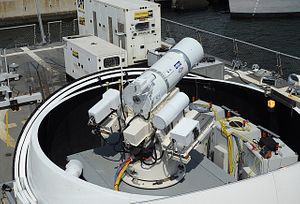With the U.S. Navy’s new laser weapon, known as LaWS, being deployed in the Persian Gulf, the U.S. has taken an important technological step forward that should send a message to its enemies in addition to improving the defense of its ships. The political significance of LaWS lies, in part, in its potential deterrent effect — it may well be that potential enemies will think twice about approaching U.S. Navy ships when they are faced with an invisible weapon that can destroy its targets at the speed of light.
Another argument in favor of this weapon is that it significantly reduces cost of use. When compared to shells or missiles, which can cost over $1 million per shot to fire, the LaWS weapon uses a mere $0.59 worth of energy per shot. That this has been widely touted as a positive aspect of the weapon is not surprising, since Americans seems to reside these days in a cultural milieu in which the bottom line is really the only thing that matters. Of course, when this figure is mentioned, there is rarely an accompanying figure laying out what it cost to develop the weapon in the first place.
While the cost of use is important, we should give some thought to other potential consequences of weapons like LaWS — particularly when it comes to how the low cost of using the weapon might influence decision-making about how and when to use it. Deterrence is a multi-directional factor. We can see this in the hesitance to use weapons like nuclear missiles that not only have a deterrent influence on the potential target, but also on the potential user who must give thought to the human, political, and moral consequences of employing these or other types of weapon of mass destruction.
When it comes to conventional weapons, although the U.S. government rarely seems to be deeply concerned about cost when it comes to waging war — in contrast to decision-making about providing services like good education, which routinely is a target of cost-cutting measures — one would hope that at some level leaders in the military, Congress, and the administrative branch would see the enormous cost of using conventional weapons (and replacing them) as some sort of deterrent to going to war. Unfortunately, I’m not sure this is true, but one hopes so.
So developing weapons that are cheap to use should be a good idea, right? At least when we go to war, it won’t cost the American taxpayer (or taxpayers in other countries that develop similar technologies) quite so much to defeat and deter the enemy and this is a good thing. Or is it? Perhaps the low cost of using weapons like LaWS will make it easier for political leaders to engage in military actions — not that they’ve found it very difficult to do so over the past 50 or more years. In other words, a potential byproduct of low cost is that it increases ease of use. It’s like buying cheap goods from China — they may be junk, but they are so cheap that we can buy a lot of them and use them up freely instead of using our resources carefully on quality goods that last a long time.
The troubling feature of low cost (per use) of weapons like LaWS is that they have the potential to commodify not simply the production of military technology, but also its use in a way that makes it so cheap per shot that there is no inherent reason not to use the technology and to do so often. In other words, there is nothing deterring the owners of such technologies from using them at will beyond any moral hesitation that might exist in the minds of politicians — and we’ve seen how well that’s worked out with conventional warfare since the end of World War II.
While LaWS represents a significant leap forward in military technology, the cost of using it also raises the potential to apply an economy of scale to its application. And as the technology proliferates to contexts like East Asia — and it eventually will — it may make the world a significantly more dangerous place, because the low cost of using laser weapons provides little or no deterrence to the politicians who lead us into war, and may even incentivize that use.
John W. Traphagan, Ph.D. is Professor of Religious Studies and Centennial Commission in the Liberal Arts Fellow at the University of Texas at Austin.

































